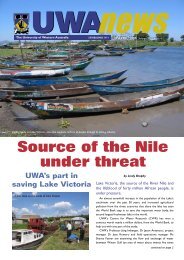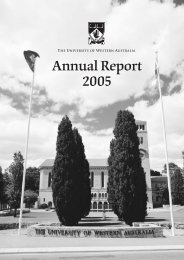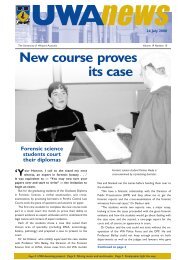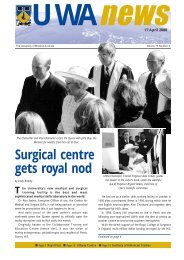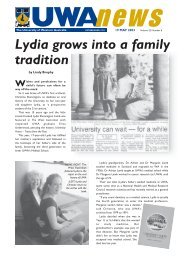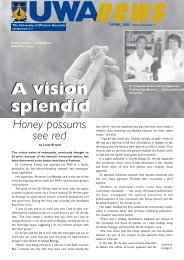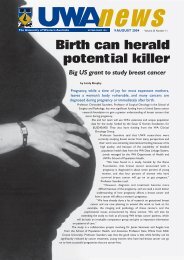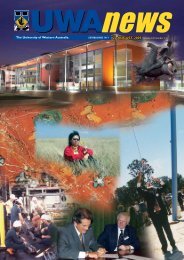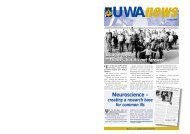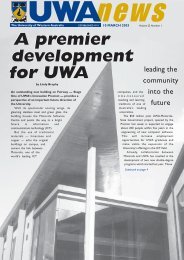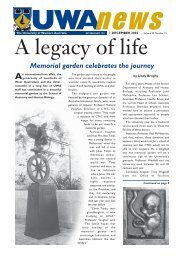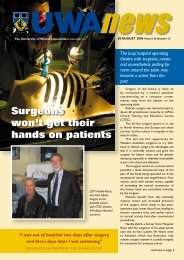Untitled - Annual Report 2004 - The University of Western Australia
Untitled - Annual Report 2004 - The University of Western Australia
Untitled - Annual Report 2004 - The University of Western Australia
You also want an ePaper? Increase the reach of your titles
YUMPU automatically turns print PDFs into web optimized ePapers that Google loves.
Indicator 1.5 Expenditure RatiosEfficiency indicators are intended to show the relationship between the resources used and the outputs produced. In the higher educationsector, one measure <strong>of</strong> the resources is the expenditure attributed to teaching, while the outputs may be defined in terms <strong>of</strong> the number <strong>of</strong>graduates or equivalent full-time students.<strong>The</strong> major source <strong>of</strong> funds used for teaching is the Commonwealth operating grant that is primarily determined on the basis <strong>of</strong> a negotiatedstudent load mix. Essentially the same rate <strong>of</strong> funding applies to each course type/discipline category in the load target negotiated by eachinstitution in the Unified National System. As a consequence, figures on expenditure per equivalent full-time student unit (EFTSU) reflect thestudent load mix.<strong>The</strong> fees for overseas students are set in a competitive environment and therefore reflect the perception <strong>of</strong> the <strong>University</strong>’s courses; apremium is earned for courses with high demand and is usually used for teaching purposes. Thus high expenditure figures may reflect theperceived quality <strong>of</strong> courses.<strong>The</strong> following table presents ratios <strong>of</strong> the total expenditure (excluding research only expenditure) to the equivalent full-time units andweighted student units <strong>of</strong> all students at the <strong>University</strong>. It shows a 16.9 per cent increase in the expenditure per EFTSU and a 16.8 per centincrease in expenditure per weighted student unit at this <strong>University</strong> over the 2000 to <strong>2004</strong> period. Expenditure per course completionincreased by 2.3 per cent from 2000 to 2003 while expenditure per weighted course completion decreased marginally by 0.7 per cent overthe same period.Expenditure Ratios, 2000 to <strong>2004</strong>2000 2001 2002 2003 <strong>2004</strong>Expenditure (a) / EFTSU 21,067 21,343 22,245 25,005 24,638Expenditure (a) / Weighted Student Units (b) 18,491 18,802 19,595 21,980 21,595Expenditure (c) / Course Completion 70,753 70,809 69,298 72,353(e)Expenditure (c) / Weighted Completion (d) 60,123 58,846 57,665 59,712(e)(a)Total expenditure excluding research only expenditure and Perth International Arts Festival expenditure, indexed to <strong>2004</strong> dollar values(b)Weighted student units calculated by multiplying student load in higher degree research by 2.0, other postgraduate and honours by 1.3 and bachelor’s(including graduate entry) by 1.0.(c)Total expenditure (in <strong>2004</strong> dollar values) excluding research only expenditure averaged over last three years.(d)Weighted by multiplying the number <strong>of</strong> completions in higher degree research by 2.0, other postgraduate and honours by 1.3 and bachelor’s (includinggraduate entry) by 1.0.(e)<strong>The</strong> number <strong>of</strong> completions for <strong>2004</strong> will not be available until May 2005.91



